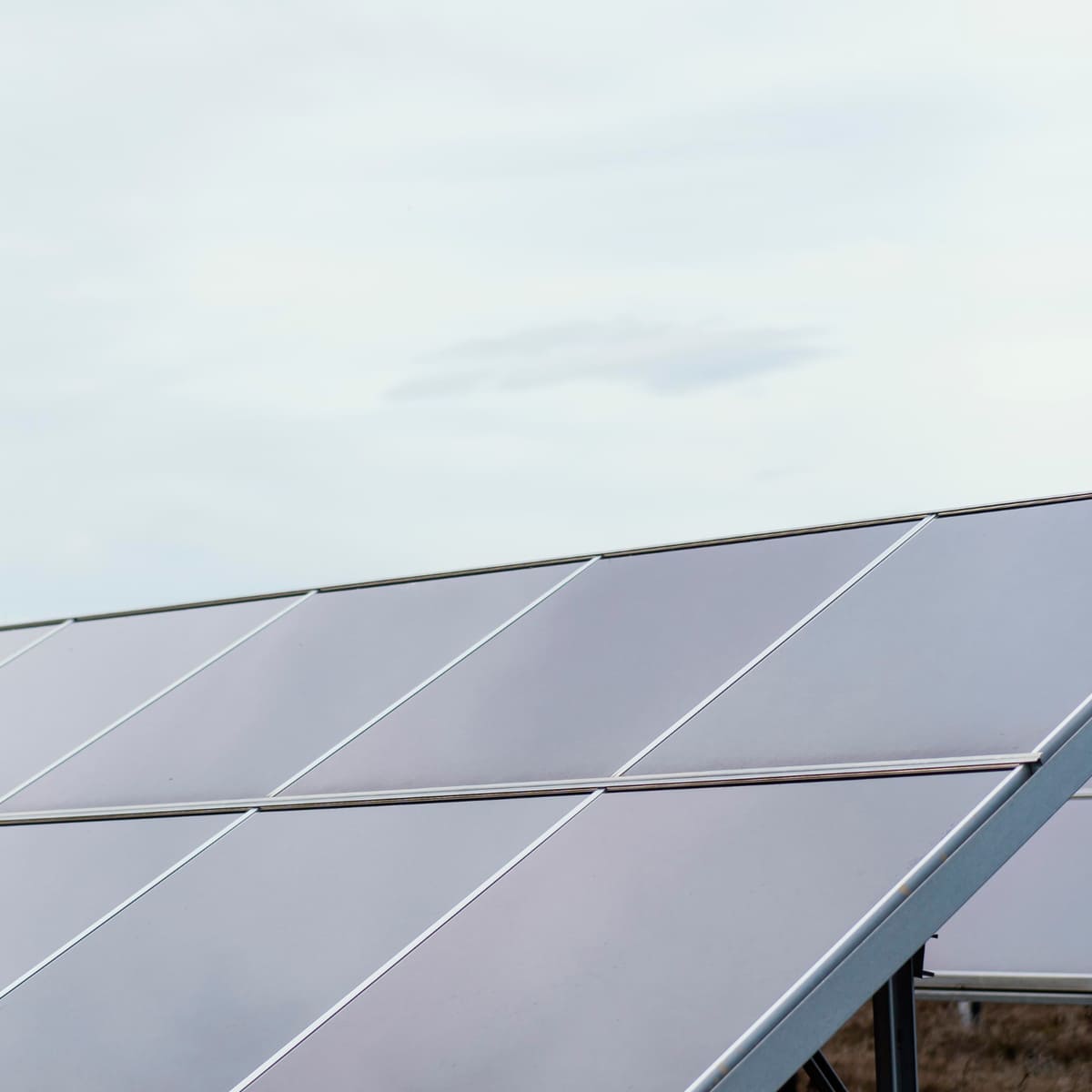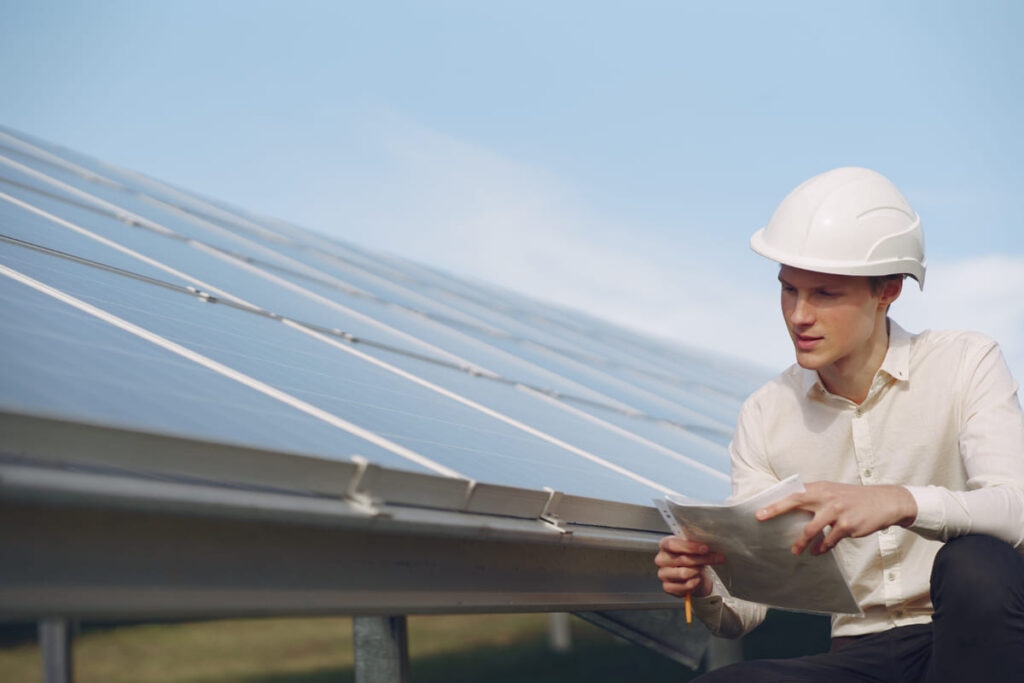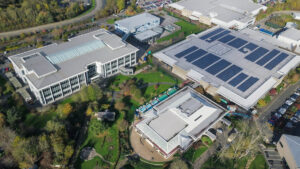Lightweight rooftop solar panel technology is enabling solar on rooftops that could not support heavy glass panels. Modern systems weigh as little as 3–6 kg/m², compared to roughly 20–30 kg/m² for conventional modules. This has opened new possibilities for older structures, warehouses, and low-load roofs. One market report projects that global lightweight rooftop PV capacity will grow from ~570 GW in 2023 to over 930 GW by 2034. Much of this growth is in Europe (countries like Germany, France and the Netherlands) under strong solar incentives, as well as in rapidly industrializing markets in Asia and North America. The sections below highlight six key innovations in lightweight solar panel technology that are transforming commercial rooftops worldwide.
Table of Contents
Flexible Thin-Film Modules
Flexible thin-film solar panels use materials like copper indium gallium selenide (CIGS) or cadmium telluride (CdTe) to create lightweight modules. These semiconductors are deposited on polymer or metal-foil backings, resulting in thin, bendable panels. Modern flexible CIGS mini-modules have achieved efficiencies above 18% while keeping weight extremely low. For example, a Dutch manufacturer’s polymer-backed CIGS panels weigh only about 5.5 kg/m², enabling installation on roofs with limited load capacity.
Key features include:
-
Lightweight materials: Thin semiconductor films on polymer/foil substrates dramatically reduce weight.
-
Easy installation: Panels can be bonded directly to roof membranes or mounted with light ballasts, eliminating heavy racks.
-
High efficiency: Advances in thin-film processing yield commercial efficiencies in the high teens (greater than 18%).
-
Versatility: Flexible modules conform to curved or irregular surfaces (e.g., metal or polycarbonate roofs) and are easier to transport and handle.

Perovskite Solar Cells
Perovskite solar cells are an emerging technology that uses a crystalline perovskite compound as the light-absorbing layer. These materials can be deposited in very thin, lightweight films. Perovskite cells have demonstrated high efficiencies (research devices exceeding 25%) and can be manufactured by low-cost coating or printing processes. Recent prototypes combine perovskite absorbers with lightweight polymer covers, producing flexible modules around 5–6 kg/m² without glass. This design makes the overall module much lighter than conventional panels.
Key features include:
-
High efficiency: Perovskite layers can achieve conversion efficiencies above 25% in lab cells. They can also be stacked over silicon cells in tandem configurations to boost total system output.
-
Lightweight design: A thin perovskite film (micrometers thick) adds minimal weight. By using polymer encapsulation instead of glass, researchers have built panels around 5–6 kg/m².
-
Roll-to-roll manufacturing: Perovskite layers can be coated or printed on flexible substrates in a continuous process, enabling scalable, low-cost production.
-
Challenges: Long-term stability and durability are current concerns. Perovskites can degrade with moisture and heat, and some contain lead. Research is ongoing to improve stability and reduce toxic materials.
Suggested article to read: Solar Panel in Building; Everything You Need to Know in 2024

Quantum Dot Solar Panels
Quantum dot solar cells use nanoscale semiconductor particles (quantum dots) to absorb sunlight. Each quantum dot is tuned to a specific wavelength, allowing these cells to capture a wider spectrum of light than conventional silicon. The resulting panels are inherently lightweight and often flexible, since the active layer can be printed or coated onto plastic substrates.
Key attributes include:
-
Lightweight and flexible: Quantum dot PV films are very thin and bendable, making them easy to install on irregular or curved surfaces.
-
Broad-spectrum absorption: By adjusting dot sizes, these panels harvest more of the sun’s spectrum, improving performance in low-light or diffuse conditions.
-
Transparency and BIPV: Semi-transparent quantum dot films can be used as skylights or facade glazing, letting light through while generating power.
-
Multi-junction capability: Quantum dots can be layered atop traditional solar cells (forming tandem or multi-junction modules) to capture wavelengths that silicon cells miss.
Building-Integrated Photovoltaics (BIPV)
Building-integrated photovoltaics (BIPV) embed solar cells directly into roof or facade materials. By replacing conventional roof components (tiles, skylights, membranes) with PV, these systems minimize extra weight. For example, researchers demonstrated a ventilated PV roof module (with a polymer cover) that weighs only about 3 kg/m² per module and adds roughly 6 kg/m² in total when mounted. An air channel under the panels reduces cell temperature and improves energy yield compared to standard rooftop PV.
Key aspects of BIPV include:
-
Integrated roofing materials: PV cells are embedded in roof tiles or membrane panels, serving as both weatherproofing and power generation.
-
Light-transmitting elements: Solar glass and translucent PV panels function as skylights or facade cladding, admitting daylight while generating electricity.
-
Minimal structure: Frameless or low-profile modules require little support; ventilated designs improve airflow and shed heat.
-
Aesthetic benefits: BIPV preserves the building’s appearance and may qualify for special solar incentives or credits in many regions.
Innovative Mounting & Installation Methods
New mounting techniques further reduce weight and install time for rooftop solar. Frameless panels with integrated adhesive backing can adhere directly to roofs. For example, Maxeon’s “Air” panels use a polymer front and no metal frame or glass, resulting in an installed load of only ~6 kg/m². These adhesive systems eliminate the need for racks, anchors, or heavy supports, greatly simplifying installation.
Key innovations include:
-
Adhesive-mounted panels: Panels with built-in adhesives or bonding tapes stick to roof membranes (even uneven surfaces), avoiding nails or bolts.
-
Ballasted arrays: Low-profile mounting trays use concrete or plastic blocks to hold modules in place. Lightweight panels pair well with ballasts to secure arrays on flat roofs without penetrating the roof membrane.
-
Prefabricated mounting systems: Some panels attach to folding or clip-in frames. These “roll-out” or “snap-in” designs allow one-person installs and reduce assembly time.
-
Solar roofing membranes: Integrated solar mats combine the roofing material and PV module into one layer, cutting installation steps.

Smart Controls and Energy Management
Modern lightweight systems often incorporate advanced power electronics and networking to optimize performance. Module-level power electronics (such as microinverters or DC optimizers) enable each panel to operate independently, maximizing output under partial shade or mismatch conditions. Many products also include IoT sensors and software platforms, allowing building managers to monitor each panel in real time and receive alerts if performance drops.
Key features include:
-
Module-level electronics: Inverters or optimizers at each panel improve energy harvest and fault tolerance – one failing panel no longer drags down the whole array.
-
IoT monitoring: Cloud dashboards and mobile apps provide live data on production and panel health, enabling proactive maintenance.
-
Energy management: Smart controllers coordinate solar output with battery storage and building loads, ensuring generated power is used efficiently.
-
Future connectivity: Emerging systems may include AI-driven optimization and dynamic grid services to balance building demand with local solar generation.
FAQs
How do lightweight rooftop solar panels differ from conventional panels? Lightweight panels use much thinner or flexible materials (such as polymer substrates and thin-film cells) instead of heavy glass and frames. This drastically reduces weight (often to a small fraction of a traditional panel) while delivering comparable power output. The result is a panel that can bend or conform to roof shapes, expanding installation options for structures that cannot support standard solar arrays.
What materials are used in lightweight solar panel technology? Common lightweight PV materials include flexible thin-film semiconductors (CIGS or CdTe), emerging perovskite and quantum dot absorbers, and engineered polymers. These active materials are often laminated on plastic or composite backings instead of glass. For building-integrated solutions, lightweight engineered glass or translucent polymers are used for solar skylights, tiles, and facades.
Which roofs benefit most from lightweight solar panels? Roofs with strict weight limits or nonstandard structures benefit the most. For example, older warehouses, stadiums, retrofitted transit hubs, curved metal roofs, and polycarbonate skylights can adopt lightweight solar without major reinforcement. In general, any commercial roof where adding 20–30 kg/m² (a typical glass panel weight) would require expensive upgrades is an ideal candidate for lightweight PV.
Is it true that lightweight solar panels are less durable than standard panels? Not necessarily. Early lightweight panels had shorter warranties (often 10–15 years versus the 25-year norm for glass modules), but durability has been improving. Many modern lightweight panels use weather-resistant polymer laminates and flexibility-enhanced cells that resist hail, UV and thermal stress. High-end flexible PV now comes with warranties closer to traditional panels, and ongoing R&D is focused on matching or exceeding those lifespans.
Conclusion
In summary, a combination of material science, design innovation, and smart technology is making lightweight rooftop solar panels practical for commercial buildings of all types. Flexible thin-film and polymer-based panels dramatically cut weight, while BIPV and frameless designs integrate seamlessly into roofs. Advanced mounting solutions and digital energy management systems further enhance performance and lower costs. Together, these developments allow solar power to be deployed on weight-sensitive rooftops without expensive reinforcements – supporting corporate sustainability goals on almost any building.
Resources:
Nations Roof®. (2024). Advancements in Roof-Mounted Solar Panels for Commercial Use.
Pv-magazine, Thompson, V. (2025). TNO, Solarge unveil lightweight perovskite solar module prototype.
Pv-magazine, Thompson, V. (2023). Lightweight PV system solution for commercial buildings with limited load-bearing capacity. Available at:
Pv-magazine, Bellini, E. (2024). Lightweight ventilated BIPV system for low-load rooftop applications.
Whole Building Design Guide. (2023). Building Integrated Photovoltaics (BIPV).
npj Flexible Electronics Ishizuka, S. et al. (2022). Lightweight and flexible Cu(In,Ga)Se2 solar minimodules: toward 20% photovoltaic efficiency and beyond..
Pv-magazine, Sylvia, T. (2021). Maxeon launches frameless rooftop solar panels.
For all the pictures: Freepik
Suggested article for reading:
How Sensor Startups Reshaping the Future of Construction Monitoring 2025
7 Benefits of Transparent Solar Panels in Urban Architecture
Top 10 Sensor Companies Powering Smart Construction in 2025
5 Game‑Changing BIPV Technologies Powering Modern Buildings in 2025
Top 10 Asset Tracking Software Solutions for Businesses in 2025





